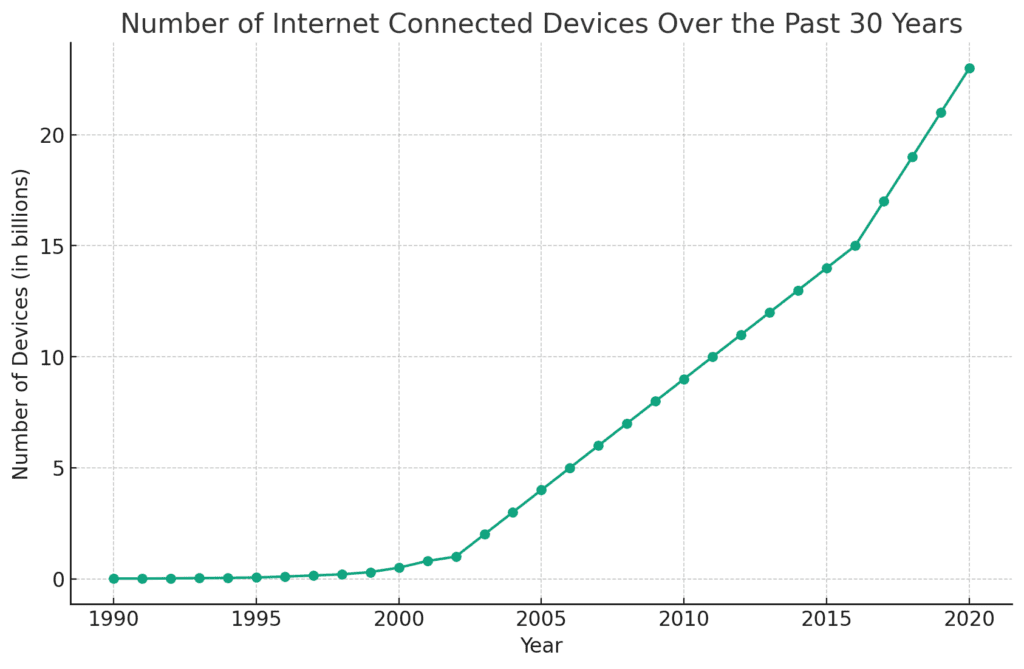In the last three decades, we’ve witnessed an unprecedented digital revolution. The number of devices connected to the internet has skyrocketed, changing how we live, work, and communicate. In the span of just three decades, the landscape of technology and connectivity has undergone a seismic shift. The number of devices connected to the internet has multiplied exponentially, deeply influencing the fabric of daily life, especially in developed countries.
The Digital Device Explosion:
From the nascent stages of the internet in the early 1990s to the vast digital ecosystem of the 2020s, the growth in internet-connected devices is nothing short of phenomenal. A study by Statista reveals that as of 2020, there were over 22 billion connected IoT devices worldwide, a number predicted to double by 2025.
The Rise of Connected Devices:

The graph from 1990 to 2020 illustrates an explosive increase in internet-connected devices. Starting from a modest count in the early ’90s, we now have billions of devices online. This growth reflects the proliferation of smartphones and computers and the advent of the Internet of Things (IoT), where everyday objects from refrigerators to thermostats are becoming smart and connected.
Interacting with Digital Devices:
The average consumer in developed countries now spends a significant portion of their day interacting with digital devices.
- Daily Interaction:
- On average, people spend about 6-8 hours daily on digital devices, including smartphones, computers, and tablets.
- Weekly Engagement:
- Weekly, this usage accumulates to about 42-56 hours, equivalent to a full-time job.
- Monthly Usage:
- Monthly, the average user spends approximately 180-240 hours online, varying based on profession and lifestyle.
- Annual Interaction:
- On an annual basis, this equates to roughly 2,160-2,880 hours, which is a substantial portion of one’s waking hours.
Implications of High Device Usage:
Dr. James Roberts, a professor at Baylor University and an expert on technology addiction, warns, “Our incessant attachment to digital devices is leading to a ‘digital overload,’ impacting our mental health and social relationships.”
Similarly, Sherry Turkle, a professor at MIT and author of “Alone Together,” notes, “Technology promises to let us do anything from anywhere with anyone. But it also drains us as we try to do everything everywhere.”
This extensive interaction with digital devices has profound implications:
- Productivity and Work: While technology has boosted productivity and connectivity in the workplace, it has also blurred the lines between work and personal life.
- Social Impact: Social media and online platforms have transformed how we socialize, offering both opportunities for global connection and challenges like digital isolation.
- Health Concerns: Prolonged screen time raises health concerns, including impacts on vision, sleep patterns, and mental health.
The digital era has brought remarkable advancements, but it’s also essential to be mindful of our digital consumption. As we continue to embrace technology, finding a balance that benefits our productivity, social life, and health is vital. The rise in digital device usage is not just a trend but a fundamental shift in how we interact with the world around us.
While the digital revolution has undoubtedly brought efficiency and connectivity, it also poses challenges that require conscious navigation. Balancing technology use with physical and mental well-being is becoming increasingly essential. As Dr. Roberts suggests, “It’s about finding a way to use technology as a tool, not a tether.” This balance is crucial as we forge ahead in an ever-more connected world.





